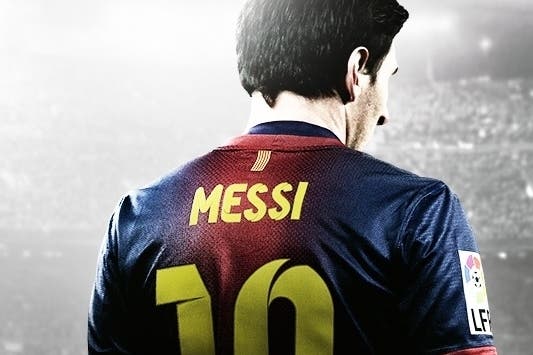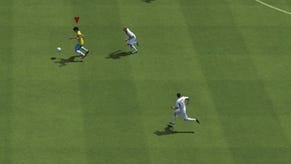Next-Gen Face-Off: FIFA 14
FIFA vendetta.
Achieving the rare feat of platform parity on both PS3 and 360, the FIFA series now takes its first dive onto the succeeding consoles, taking advantage of the spec upgrade with EA Canada's brand new Ignite Engine. On the Xbox One and PS4 versions we're promised more than just a resolution increase - the new technology also brings a sharp increase in player animations, smarter AI, and fully polygonal 3D crowds to replace the sprite-work of previous games. But with this visual upheaval, and the rush to be there for day one of the console launches, has the series' history of platform parity been maintained for the new generation?
To start things off, it's clear from the get-go that the fundamentals of FIFA's design haven't changed, and that the Ignite Engine essentially re-uses the same rendering techniques for player models, alongside plenty of motion capture data we've seen before. This extends to the gameplay, meaning those familiar with FIFA 14's slower accelerating players and balance in favour of lobbed balls will very much be at home with these next-gen offerings. However, eye-opening changes are in effect here - if not always evident under the skin so much as in terms of the gloss spread over the top.
By far the most eye-catching upgrade is the bump up from 720p to a full 1080p native resolution, which we can confirm is common to both Xbox One and PS4. Like seeing any sports broadcast making the move to HD, the boost in pixel definition adds greatly to the spectacle, and increasingly we find we can pick out players by eye rather than resorting to the call-outs from the commentary. This crisp 1080p presentation is something we've only enjoyed on the PC versions of the series so far - though curiously this format has no support for the revised Ignite Engine so far.
Simply bringing a 1080p picture to the table isn't always enough, however, when the goal is to squeeze out the best image quality possible. This is especially true of sports games, where the camera is withdrawn from the characters in control more than most, and for which jagged edges can still be a distraction at full HD. Thankfully, EA Canada has managed to leverage a 2x pass of multi-sample anti aliasing (MSAA) into both versions of the game - something of a rarity in console development these days. This is an approach which addresses edges on geometry early on in the rendering pipeline, avoiding the need to soften the entire image with cheaper post-processing methods.
"By far the most eye-catching upgrade is the bump up from 720p to full 1080p, common to both Xbox One and PS4. Like seeing any sports broadcast making the move to HD, the boost in pixel definition adds greatly to the spectacle."
High quality download: Host/Mirror (right-click, save as)
This choice of AA ties in nicely with the introduction of fully realised 3D crowds on Xbox One and PS4, where previously the 360 version - with its likewise 2x MSAA - produces an ugly shimmer effect while panning past spite-based crowds. Although this is essentially an aesthetic tweak, seeing these spectators pack the stadium aisles in their hundreds is an impressive technical feat given the seating capacities of some grounds. Getting the camera too close inevitably shows shortcomings, but their ability to switch animations according to the on-pitch action helps add to the game's atmosphere - and some even flinch as a wayward shot rockets towards them.
But most of our attention is be held by the on-pitch action, where players have seen a suitable upgrade in their own right, mostly boiling down to the addition of cloth simulation and improved skin shaders. The former sticks out especially, allowing for an elastic stretch around the torso of players like Gareth Bale, while most other kits sag and crease up with each stride. If there is a criticism here, it's that shorts swing like pendulums when players are running full-pelt, looking rather bizarre in replays.
Texture filtering is also improved over current-gen, meaning insignia and grass are no longer blurred, and the Barcelona crests spread around the Nou Camp appear crisp and defined. There's also a more generous use of grass when the camera draws closer to ground level for penalty shoot-outs, which stand out thanks to the resolution bump, avoiding the rather flat texturing of the current-gen versions.
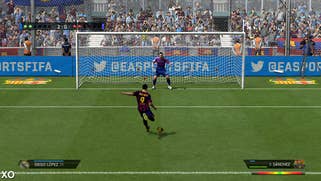

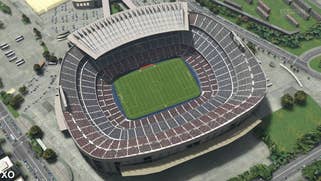

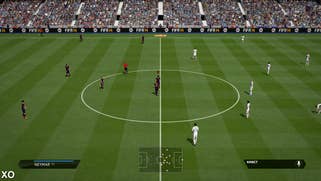


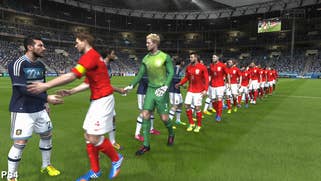
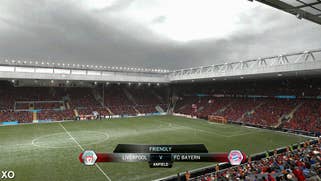
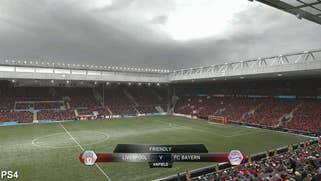
As for contrasts between the Xbox One and PS4 releases go, there's very little to distinguish the two on visual grounds. To developer EA Canada's credit, there are only a few odd visual glitches noticed here, such as a flickering referee during one of our exhibition games. Otherwise, putting the games side by side reveals a slight gamma variance that gives the Xbox One a more vivid colour palette, despite brightness settings being level on each.
Save for this one discrepancy, the results are largely identical. Given that the PS4 has enjoyed a clear technical advantage in recent games like Battlefield 4 or Call of Duty: Ghosts, it's a surprise that these two releases are so difficult to distinguish. But with this in mind, we turn to our performance tests to see whether both platforms hold true to the 60fps standard of current-gen versions.
For games played from the default viewpoint, we're pleased to find a pure 60fps experience unfolds on both Xbox One and PS4, with nary a dropped frame during match-ups at Anfield, Wembley or Nou Camp. True to series tradition, it is perhaps a slight disappointment that playing with the Pro camera forces the game to lock at 30fps - and likewise for penalties, corners, replays and goal celebrations. However, for the stretches of play where controller response counts most, the frame-rate is perfectly optimised on each platform.
"As performance metrics stabilise at either a clean 30 or 60fps, we're left short on ways to truly distinguish the two next-gen versions on any technical level."
FIFA 14: the Digital Foundry verdict
As performance metrics stabilise at either a clean 30 or 60fps, we're left short on ways to truly distinguish the two next-gen versions on any technical level. That being the case, it's worth noting the Xbox One version does offer a minor advantage in content with its exclusive Ultimate Team "Legends," opening up access to classic players like Pelé, Lineker and Zola. It's perhaps not the most essential feature given the rarity of these cards, and the potential expenditure on packs to seek them out, but it's a clear point in favour of the Xbox One release.
Speaking of content, certain modes are stripped back compared to the PS3 and 360 editions - Be a Pro and Tournament options, for example. Getting the game out in a reasonable time-frame likely took precedence this year, but on the plus side, the honed focus does mean the Ignite Engine lands on both feet to give the definitive on-pitch experience.
In all, putting aside nit-picks in gamma that suggest a slight black push on the Xbox One, both releases are a match in every other conceivable sense. The 1080p presentation backed up by 2xMSAA is sumptuous to behold, and sidesteps the upscaling and post-processing seen in other games that tend to spoil all the hard work. As a result, FIFA 14 easily ranks as the most crisply presented next-gen game released yet, and for time time being, a solid showcase of the next-gen difference to any passer-by.
